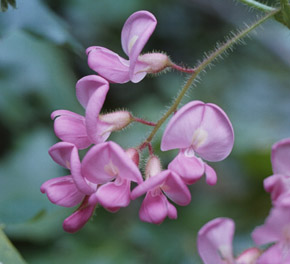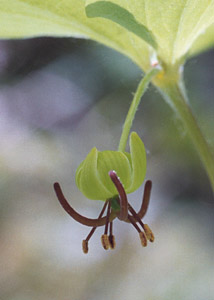

 |
 |

 |
Indian cucumber-root (Medeola virginiana) blooms discretely in wooded areas in early June. The small spiderly flowers dangle from the plant's upper whorl of leaves. The plant is a member of the lily family.
The name refers to the Native American practice of digging the roots for food. The root is crisp and tastes and smells like cucumber. Native Americans also used to spit chewed root on their hooks to get fish to bite.
Birds like the berries, which turn bluish when they ripen in late summer. At that time, the base of
the leaves loses color or turns red, signaling the presence of berries.
False Hellebore or Indian Poke, Lily family (Liliaceae), Native

|
In late spring, the cornstalk-like plants of false hellebore (Vertrum viride) quickly grow tall in swampy areas. Their large pleated leaves are distinctive with several parallel ribs. The plants produce numerous greenish flowers crowded on graceful branches and then die back after flowering. Indian poke is another common name for this member of the lily family.
False hellebore is toxic to grazing animals and has been shown to produce birth defects in sheep.
| hide TOC | 
|
| Home / Contact | ||
Copyright © Anne A. Reid, 1999-2002. Photographs copyright © Garry K. Kessler, 1999-2002. | ||